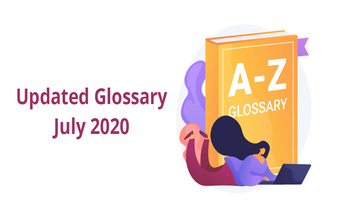Alexa Voice Service (AVS):
Amazon’s service offering for a voice-controlled AI assistant. Offered in different products.
Source: https://whatis.techtarget.com/definition/Alexa-Voice-Services-AVS
Autopilot
Short for “automatic pilot,” a device for keeping an aircraft on a set course without the intervention of the pilot.
Source: https://en.oxforddictionaries.com/definition/us/automatic_pilot
Blockchain Infrastructure:
A complex, decentralized architecture that orchestrates many systems running asynchronously over the internet in order to create a secured database that records sensitive data of certain users into forms of transactions,
Source: https://blockgeeks.com/guides/what-is-blockchain-technology/
Chatbot:
An automated program that interacts with people using generated responses from keywords.
Source: https://searchcustomerexperience.techtarget.com/definition/chatbot
Continuous Delivery (CD)
Continuous Delivery is the ability to get changes of all types—including new features, configuration changes, bug fixes, and experiments—into production, or into the hands of users, safely and quickly in a sustainable way.
Source: https://continuousdelivery.com/
Continuous Integration/Continuous Delivery (CI/CD)
Continuous integration and continuous deployment merge development with testing, allowing developers to build code collaboratively, submit it to the master branch, and check for issues.
Source: https://www.atlassian.com/continuousdelivery/ci-vs-ci-vs-cd
Continuous Testing (CT)
Continuous Testing was originally proposed as a way of reducing waiting time for feedback to developers by introducing development environment-triggered tests as well as the more traditional developer/tester-triggered tests. Continuous Testing is the process of executing automated tests as part of the software delivery pipeline to obtain immediate feedback on the business risks associated with a software release candidate. For Continuous Testing, the scope of testing extends from validating bottom-up requirements or user stories to assessing the system requirements associated with overarching business goals.
Source: https://en.wikipedia.org/wiki/Continuous_testing
Context-Aware
Context-aware mobility provides the ability to dynamically capture and use contextual information about mobile assets to optimize, change, or create communications flow and business processes. Contextual information can be collected for any mobile asset involved in a business process, and this includes not just devices and products but also people. For instance, a mobile asset can be a worker, a customer, or a patient, or it can be a pallet of finished goods.
Conversational User Interface (CUI):
Any interface that can converse with people on a personal, social level.
Source: https://blog.aimultiple.com/conversational-ui/
Framework:
An abstraction in which software providing generic functionality can be selectively changed by additional user-written code, thus providing application-specific software. A software framework is a universal, reusable software platform used to develop applications, products, and solutions.
Source: https://en.wikipedia.org/wiki/Software_framework
Intelligent Virtual Assistant (IVA):
An automated AI system that can perform human-like tasks, such as grocery shopping or scheduling appointments.
Source: https://www.interactions.com/blog/intelligent-virtual-assistant/rise-intelligent-virtual-assistants/
Load Testing:
The process of putting demand on a system or device and measuring its response. Load testing is performed to determine a system’s behavior under both normal and anticipated peak load conditions. It helps to identify the maximum operating capacity of an application as well as any bottlenecks and determine which element is causing degradation.
Source: https://en.wikipedia.org/wiki/Load_testing
Maintainability:
The ease with which a product can be maintained in order to: isolate defects or their cause, correct defects or their cause, meet new requirements, make future maintenance easier, or cope with a changed environment.
Source: http://acqnotes.com/acqnote/careerfields/maintainability
Mobility
While mobile usually refers to mobile device, mobile apps, mobile platform. Mobility is a term describing not only the device but access for employees accessing corporate data from any location, cloud storage and cloud API services, mobile context awareness, integration with a variety of Internet of Things devices. It’s access to the data, products, and services enabled by being mobile.
Source: https://magazine.logigear.com/glossary/glossary-mobile-testing-2/
Natural Language Processing (NLP):
The ability for a computer to comprehend spoken or written word, enabling interaction between humans.
Source: https://www.sas.com/enus/insights/analytics/what-is-natural-language-processing-nlp.html
Natural Language Understanding (NLU):
A category of Natural Language Processing that deals with machine reading comprehension.
Source: https://www.gartner.com/it-glossary/nlu-natural-language-understanding/
Peer Testing
A way of evaluating or cross-checking the code written by developers as the developers need to be at par with each other. The time for peer testing can be mutually decided upon by the developers, which could be a weekly or a fortnightly analysis of their respective codes.
Source: http://www.professionalqa.com/peer-testing
Progressive Web Applications (PWAs)
Web applications that load like regular web pages or websites but can offer the user functionality such as working offline, push notifications, and device hardware access traditionally available only to native applications.
Source: https://en.wikipedia.org/wiki/Progressive_web_applications
Remote control
The remote control is a component of an electronics device—most commonly a television set, DVD player, or home theater system—originally used for operating the device wirelessly from a short line-of-sight distance. Remote control has continually evolved and advanced over recent years to include the internet, Bluetooth connectivity, motion sensor-enabled capabilities and voice control
Source: https://www.geospatialworld.net/entity/remote-control/
Reusability:
A segment of source code can be used again to add new functionalities with slight or no modification. Reusable modules and classes reduce implementation time, increase the likelihood that prior testing and use has eliminated bugs and localizes code modifications when a change in implementation is required.
Source: https://pdfs.semanticscholar.org/2b11/84052370115450c641c7d4ae7e19fe8dab95.pdf
ROI:
A performance measure used to evaluate the efficiency of an investment or to compare the efficiency of a number of different investments. It is one way of considering profits in relation to capital invested. In software, this can measure the beneficial effects of QA, testing and other investments on the final product’s quality and sales.
Source: https://www.investopedia.com/terms/r/returnoninvestment.asp
RFID
Radio-Frequency Identification (RFID) is the use of radio waves to read and capture information stored on a tag attached to an object. A tag can be read from up to several feet away and does not need to be within direct line-of-sight of the reader to be tracked.
Sources: https://www.epc-rfid.info/rfid
Self-healing Tests
Still, in its infancy, self-healing tests, are largely where Test Automation and artificial intelligence converge]. This is where artificial intelligence can try and learn whether a change to the website you are testing that has caused your test to fail is something that is expected. If it is identified as an expected change, the artificial intelligence will then automatically modify your code to fix the problem.
Scalability:
The ability of a system, network, or process to handle a growing amount of work in a capable manner or its ability to be enlarged to accommodate that growth. For example, it can refer to the capability of a system to increase total throughput under an increased load when resources are added.
Sources: https://en.wikipedia.org/wiki/Computer_performance
Speech Recognition Engine (SRE):
The ability for a computer to recognize spoken word and translate it into code.
Source: https://www.softwaresuggest.com/speech-recognition-engine
Test Case
A specification of the inputs, execution conditions, testing procedure, and expected results that define a single test to be executed to achieve a particular software testing objective, such as to exercise a particular program path or to verify compliance with a specific requirement.
Source: https://en.wikipedia.org/wiki/Test_case
Test Harness
A collection of software and test data configured to test a program unit by running it under varying conditions and monitoring its behavior and outputs. It has two main parts: the test execution engine and the test script repository.
Source: https://en.wikipedia.org/wiki/Test_harness
Test Plan
A detailed document that outlines the test strategy, testing objectives, resources (manpower, software, hardware) required for testing, test schedule, test estimation, and test deliverables. The test plan serves as a blueprint to conduct software testing activities as a defined process which is minutely monitored and controlled by the test manager.
Source: http://www.guru99.com/what-everybodyought-to-know-about-test-planing.html
Test Script:
The instructions in a test program. It defines the actions and pass/fail criteria. For example, if the action is “to enter a valid account number,” the expected result is that the data are accepted. Entering an invalid number should yield a particular error message.
Source: https://www.pcmag.com/encyclopedia/term/test-script
Tour Testing
A structured approach to exploratory testing where the exploration of a product is organized around a specific theme. The theme informs the type of questions that are asked and the type of observations a tester should be making.
Source: https://reqtest.com/testing-blog/what-is-tour-testing-a-structured-approach-to-exploratory-testing/
Universal Windows Platform (UWP):
An API created by Microsoft and first introduced in Windows 10; the purpose of this platform is to help develop universal apps that run on Windows 10, Windows 10 Mobile, Xbox One, and HoloLens without the need to be re-written for each. UWP allows developers to create apps that will potentially run on multiple types of devices.
Source: https://en.wikipedia.org/wiki/Universal_Windows_Platform
Visibility:
The ability to see what is truly happening to the entire or any part of the project at any point in time under any circumstance in any level of detail. Visibility is not only the collection and storage of metrics and indicators but a way to analyze, visualize, and communicate them. The ability to monitor and assess the system is the key first part of managing or directing anything.
Source: https://magazine.logigear.com/test-automation/test-automation-glossary/
Wireless technology communication protocols:
The wireless communication protocol is a standard set of rules with reference to which various electronic devices communicate with each other wirelessly.
Wearable
Wearable computers, also known as body-borne computers or wearables are miniature electronic devices that are worn by the bearer under, with or on top of clothing. This class of wearable technology has been developed for general or special purpose information technologies and media development. Wearable computers are especially useful for applications that require more complex computational support than just hardware coded logic.


















